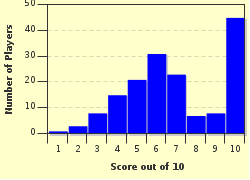Quiz Answer Key and Fun Facts
1. Is someone who is not intentionally showing signals about something, communicating?
2. At what stage of communication is a newborn infant?
3. Is the Pre-Intentional stage of communication the same as the Un-Intentional communication stage?
4. Which one of these people is in the Pre-Intentional stage of communication?
5. Is everyone able to communicate Un-Intentionally?
6. On the Communication Continuum, where does Pre-Intentional communication belong? (Note - this is from the beginning)
7. What is a good method of getting into the "world" that a person in the Pre-Intentional communication stage inhabits?
8. What is the technical term for Pre-Intentional communication?
9. Will someone in the Pre-Intentional stage of communication "comment" on events?
10. Which of these is a barrier to individuals with disabilities transitioning from the Pre-Intentional stage to the Intentional stage?
Source: Author
littlesuzie
This quiz was reviewed by FunTrivia editor
agony before going online.
Any errors found in FunTrivia content are routinely corrected through our feedback system.


